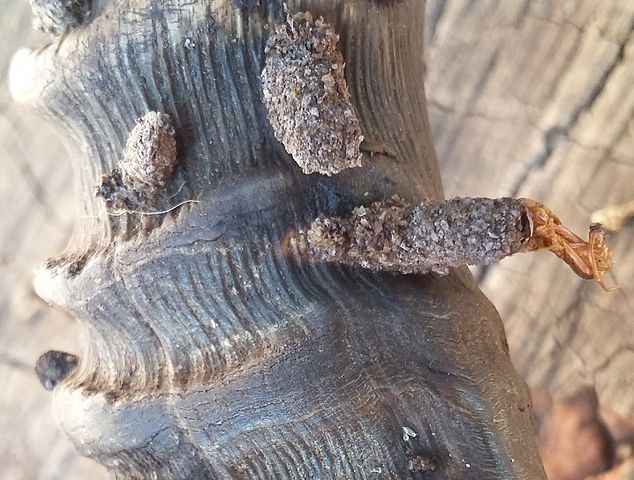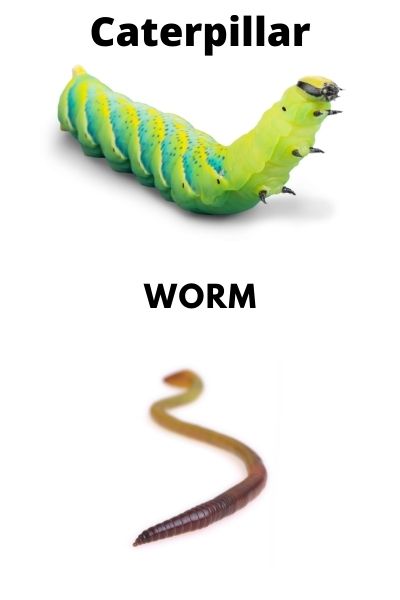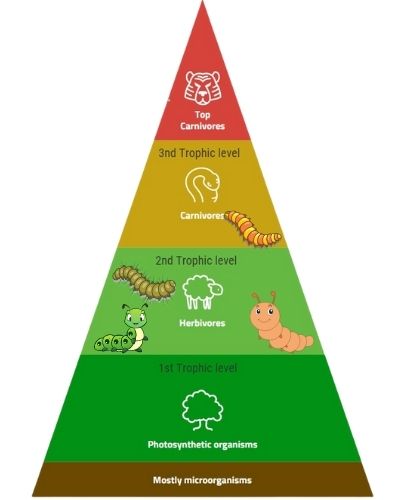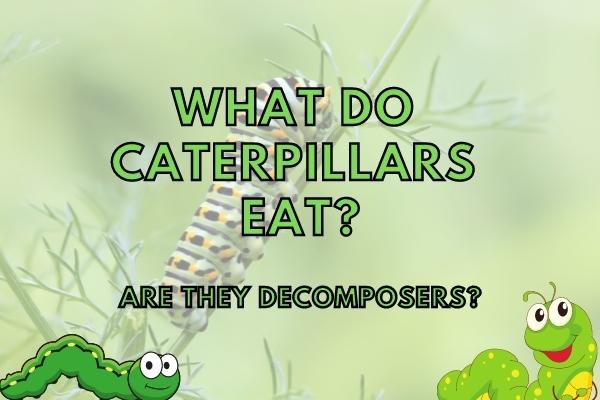Caterpillars are the larval stage of butterflies and moths. Most species of caterpillars are herbivores and feed on a wide variety of plants. Some caterpillars are primary consumers, while others are secondary or tertiary consumers.
Unlike worms, caterpillars are generally not decomposers because caterpillars mostly eat living plants. However, the caterpillar of the leaf litter moth eats fallen leafs and there are scavenging caterpillars like that of the gopher tortoise moth that eats dead tortoises!
Many caterpillars are specific to one or a few plant species and will only eat those plants. Others are generalists and will eat many different types of plants.
Some caterpillars are considered pests because they can cause extensive damage to crops or gardens. However, many people also enjoy watching caterpillars turn into beautiful butterflies or moths.
Contents
Habitat of the Caterpillar
Caterpillars live in a wide variety of habitats, including forests, deserts, and meadows.
Whereas the caterpillars of the leaf litter moth are found in the litter of the forest, the hickory tussock caterpillar is found in woodlands of the eastern United States.
The Indian meal moth caterpillar is often found in homes, where it feeds on cereals, grains, and other stored foods!
Primary Diet of the Caterpillar
Caterpillars eat leaves, fruits, and seeds. They are important herbivores in the forests. Some species of caterpillars are pests because they eat plants that are important to humans.
Depending on the type, caterpillars eat a variety of things. Some eat leaves, like the butterfly and moth caterpillars. Other caterpillars eat woody stems, like the caddisflies.
Some caterpillars eat flowers, like the butterfly and moth caterpillars. Other caterpillars eat fruits and berries, like the beetle and moth caterpillars. Some caterpillars preferentially eat roots and stems, like the turnip moth caterpillars.
Generally, the most common foods eaten by caterpillars are:
- Leaves
- Grass
- Stems
- Sap
- Flowers
- Fruits
- Seeds
Although the majority of caterpillars are herbivores, the diversity of plants eaten and the ways they feed is a bit more nuanced than that!
After nectar eaters, the most common caterpillar feeding category is that of the scavengers that make a living by eating dead animals. The gopher tortoise moth is a good example of a scavenger caterpillar!
Aside from scavenging caterpillars, a small proportion of the world’s caterpillars are carnivorous and are feeding on other animals, including flies, spiders, and even aphids and ants!
Some even eat other caterpillars, and a Hawaiian species eats snails after capturing them in a silk trap.
Feeding Habits and Digestion of Caterpillars
Caterpillars eat leaves, fruits, and seeds. Some species of caterpillars are pests because they eat plants that are important to humans.
Can Caterpillars be Carnivores or Omnivores?
Caterpillars are mostly herbivores because they eat only plants, fruits and flowers. However, some caterpillars, especially those of moths, can indeed be omnivores and carnivores!
The gopher tortoise moth and its caterpillar is an interesting example of a carnivore moth that depends on and can only survive by eating a certain type of food – the skin of the gopher tortoise!
This moth belongs to the Ceratophaga genus of horn moths that feed primarily on keratin of animals that is found in nails, hair, hooves and in the shell of a tortoise!

The gopher tortoise is a federally-protected animal but their carcasses are the main source of food for the gopher tortoise moth, who feeds on the creature’s protein known as keratin.
The keratin binds the large shell plates of the gopher tortoise together. Keratin supplies the entire lifecycle of the gopher tortoise moth.
The minute eggs are laid on the dead animal at night by a female moth, who is attracted to the carcass.
The hatching eggs also show an attraction to the tortoise. In order to protect themselves from predators, the gopher tortoise caterpillar secretes a protective tube made mostly of silk and covered with grains of sand.
The gopher tortoise eggs lay just below the dirt and allow the newly hatched creature to walk its body underground, keeping its elongated body safe from predators and weather.
Are Caterpillars Producers, Consumers or Decomposers?
Caterpillars are consumers because they need to acquire their energy from other living organisms. Caterpillars are herbivores, which means that they eat only plants.
What Type of Consumer is a Caterpillar?
Caterpillars are primary consumers because they eat only plants. Generally, herbivores are primary consumers, omnivores secondary consumers and carnivores are tertiary consumers.
Can Caterpillars be Considered Decomposers?
There are indeed caterpillars that eat dead or decaying matter and these are considered scavengers or detritivores.
The closest we get to a caterpillar that acts as a decomposer is probably the caterpillar of the leaf litter moth.
The leaf litter moth is a small, dull-colored moth that is found in wooded areas across North America. The diet of the leaf litter moth consists primarily of dead leaves and other organic matter.
The moth uses its long, slender proboscis to pierce through the surface of leaves and reach the nutrient-rich tissue beneath. This diet provides the leaf litter moth with the necessary energy to power its flight and reproduction.
The gopher tortoise moth qualifies as a scavenger, along with more infamous members of the same family, the clothes moths whose caterpillars eat clothing made from wool or fur!
It is important not to confuse worms and caterpillars as worms may indeed function as decomposers or detritivores, but not caterpillars as they only eat living plants.
What is the difference between a caterpillar and a worm?
Caterpillars and worms are both invertebrates, meaning they do not have a backbone. Both animals also have segmented bodies, which means their bodies are divided into sections by internal partitions.
However, there are several key differences between these two creatures. For instance, caterpillars have six legs located on the first three body segments just behind the head, whereas worms do not have legs at all.

Additionally, caterpillars go through a process called metamorphosis to turn into butterflies or moths, while worms do not undergo this type of change. Finally, caterpillars typically eat leaves and other plant matter, while worms consume decomposing organic material such as dead leaves and manure.
Where are Caterpillars in the Food Chain?
Caterpillars are mainly herbivores and primary consumers, and therefore they are the second trophic level in the energy pyramid. All animals that only eat plants are primary consumers and are placed on the second trophic level. However, as we have seen some caterpillars, like those of the horn moths, do also eat other animals so these would be at the 3rd trophic level.

Are Caterpillars Autotrophs or Heterotrophs?
Caterpillars are heterotrophs because they eat other living organisms. Practically no animals are autotrophic because animals do not get their energy directly from the sun like plants do. That is, animals like the caterpillar cannot make their own energy, but need to eat other organisms as their energy and carbon source.
What Animals Eat Caterpillars?
Some common predators of caterpillars are birds, such as bluebirds and robins. They eat the caterpillars as they hatch. In addition, many small mammals eat caterpillars, including bats, shrews, moles and mice. Some larger mammals that hunt and eat caterpillars include opossums, weasels, foxes and even bears!
Conclusion
In this blog post I have looked at the dietary needs of caterpillars and how they are able to make use of many different plants and fruits that are available to them.
Caterpillars are primary consumers of plants in the food chain and they are essential for the growth of other plants. They have a very interesting life cycle and I have looked at the habitat and the diet of caterpillars in this post.
Caterpillars are often the first consumers of plants and they can often be found in the understory of forests. They are an important food source for many birds and insects, and they are an important component of the food web.
Caterpillars are often eaten by birds, and they are also eaten by other animals that are part of the food chain. There are many different kinds of caterpillars and they are found in a wide variety of habitats.
I hope you enjoyed reading this post, and I do encourage you to look into my other articles on this blog for more exciting facts about wildlife and animal diets!





